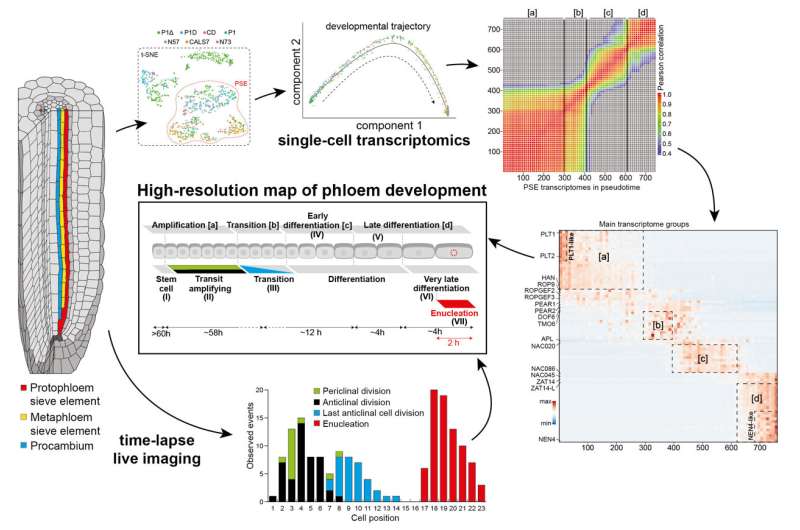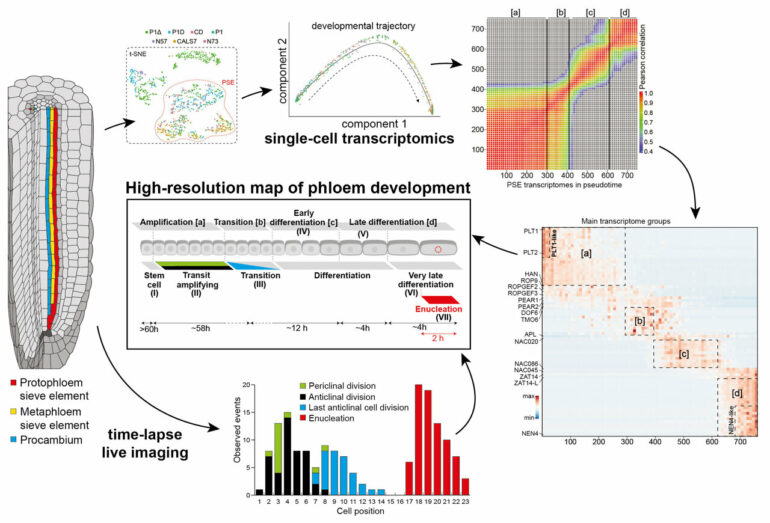A tiny region at the root tip has been found to be responsible for orchestrating the growth and development of the complex network of vascular tissues that transport sugars through plant roots.
In a paper published in Science today, an international team of scientists present a detailed blueprint of how plants construct phloem cells—the tissue responsible for transporting and accumulating sugars and starch in the parts of the plant that we harvest (seeds, fruits and storage tubers) to feed much of the world.
This pivotal research reveals how global signals in root meristems coordinate distinct maturation phases of the phloem tissue.
Phloem is a highly specialized vascular tissue that forms an interconnected network of continuous strands throughout a plant’s body. It transports sugars, nutrients and a range of signaling molecules between leaves, roots, flowers and fruits.
As a result, phloem is central to plant function. Understanding how the phloem network is initiated and develops is important for future applications in agriculture, forestry and biotechnology as it could reveal how to better transport this sugar energy to where it is needed.
How do plants build a sugar lane in a multi-lane highway?
Plant roots continue to grow throughout a plant’s life. This phenomenon, known as indeterminate growth, means roots continually elongate as they add new tissues to the tip of the root—like constructing a never-ending highway. A continuous file of specialized phloem cells running the length of roots (analogous to a lane on a highway) delivers the primary nutrient, sucrose, to the parts of the plant where it is needed for growth. To fulfill this vital role, phloem tissue must develop and mature rapidly so it can supply sugars to surrounding tissues—akin to building a service lane that needs to be completed in the first stage of constructing a multi-lane highway.

Fig 2. Phloem development at single-cell resolution. © Pawel Roszak
The problem that has long puzzled plant scientists is how a single instructive gradient of proteins are able to stage the construction phases across all the different specialized cell files (highway lanes) that are present in roots. How does one cell type read the same gradient as its neighbors, but interprets it differently to stage its own specialized development is a question that plant scientists have been working to resolve.
Over the past 15 years, researchers in Yrjö Helariutta’s teams at the University of Cambridge and University of Helsinkihave uncovered the central role of cell-to-cell communication and complex feedback-mechanisms involved in vascular patterning. This new research, undertaken with collaborators at New York University and North Carolina State University, reveals how this single lane of phloem cells is constructed independently of surrounding cells.
The Sainsbury/Helsinki group dissected each step in the construction of the phloem cell file (the sugar transport lane) in the model plant Arabidopsis thaliana using single-cell RNA-seq and live imaging. Their work showed how the proteins that control the broad maturation gradient of the root interact with the genetic machinery that specifically controls phloem development.
This is one mechanism that appears to help the phloem cell file to fast-track maturation using its own machinery to interpret the maturation cues. Dr. Pawel Roszak, co-first-author of the study and researcher at the Sainsbury Laboratory Cambridge University (SLCU), explains: “We have shown how global signals in the root meristem interact with the cell type specific factors to determine distinct phases of phloem development at the cellular resolution. Using cell sorting followed by deep, high-resolution single-cell sequencing of the underlying gene regulatory network revealed a “seesaw” mechanism of reciprocal genetic repression that triggers rapid developmental transitions.”
The group also showed how phloem development is staged over time, with early genetic programs inhibiting late genetic programs and vice versa—just as the road asphalt-laying work crews’ hand over construction to lane painters in the latter stages of highway construction. In addition, they showed how early phloem regulators instructed specific genes to split the phloem cells into two different subtypes—like the construction of a fork in the road leading to two separate destinations.
Co-leader of the work, Professor Yrjö Helariutta, said his teams’ reconstruction of the steps from birth to terminal differentiation of protophloem in the Arabidopsis root exposed the steps. Helariutta said: “Broad maturation gradients interfacing with cell-type specific transcriptional regulators to stage cellular differentiation is required for phloem development.”
“By combining single-cell transcriptomics with live imaging, here we have mapped the cellular events from the birth of the phloem cell to its terminal differentiation into phloem sieve element cells. This allowed us to uncover genetic mechanisms that coordinate cellular maturation and connect the timing of the genetic cascade to broadly expressed master regulators of meristem maturation. The precise timing of developmental mechanisms was critical for proper phloem development, with apparent “fail safe” mechanisms to ensure transitions.”
The researchers plan to further explore the evolution of these mechanisms and whether these steps are replicated in other regions of plants and other plant species.
More information:
Pawel Roszak et al, Cell-by-cell dissection of phloem development links a maturation gradient to cell specialization., Science (2021). DOI: 10.1126/science.aba5531. www.science.org/doi/10.1126/science.aba5531
Provided by
University of Cambridge
Citation:
Blueprint reveals how plants build a sugar transport lane (2021, December 23)



